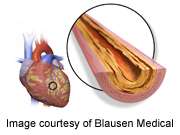Low ratio of n3:n6 fatty acids correlates with CAD progression

(HealthDay)—For statin-treated patients with coronary artery disease, decreases in the ratio of serum n-3 to n-6 polyunsaturated fatty acids (PUFAs) correlate with atherosclerosis progression, according to research published in the Jan. 1 issue of The American Journal of Cardiology.
Tsuyoshi Nozue, M.D., of the Yokohama Sakae Kyosai Hospital in Japan, and colleagues evaluated the effects of serum n-3 to n-6 PUFA ratios on coronary atherosclerosis in 101 statin-treated patients with coronary artery disease who were evaluated using virtual histology ultrasound. The patients were assessed at the time of percutaneous coronary intervention and after eight months of statin therapy.
At follow-up, the researchers found that 46 percent of patients showed atheroma progression and 54 percent exhibited atheroma regression. There were significant negative correlations seen for the change in plaque volume and in the change in fibrous component volume with the changes in the ratios of eicosapentaenoic acid (EPA)/arachidonic acid (AA), docosahexaenoic acid (DHA)/AA, and EPA+DHA/AA. The change in EPA+DPA/AA ratio was a significant predictor of the percentage change in both plaque volume and fibrous component volume in multivariate analysis.
"In conclusion, decreases in serum n-3 to n-6 polyunsaturated fatty acid ratios are associated with progression in coronary atherosclerosis evaluated using virtual histology intravascular ultrasound in statin-treated patients with coronary artery disease," the authors write.
More information:
Abstract
Full Text
Copyright © 2012 HealthDay. All rights reserved.
















